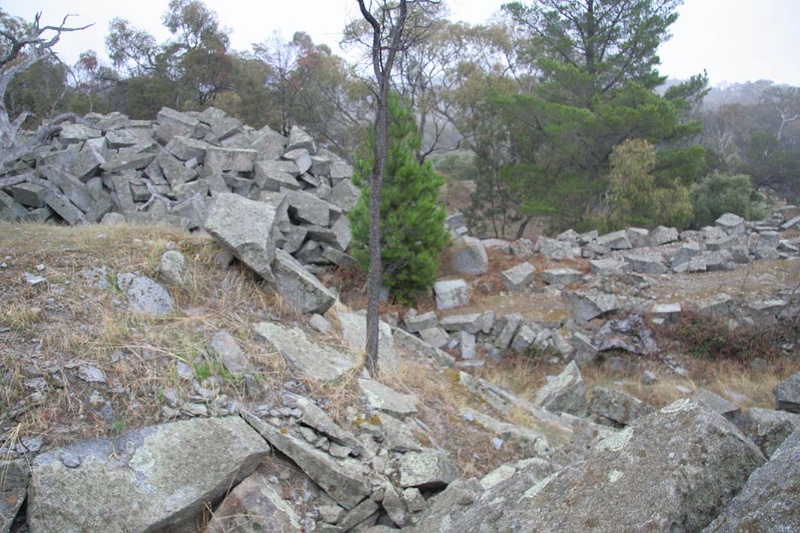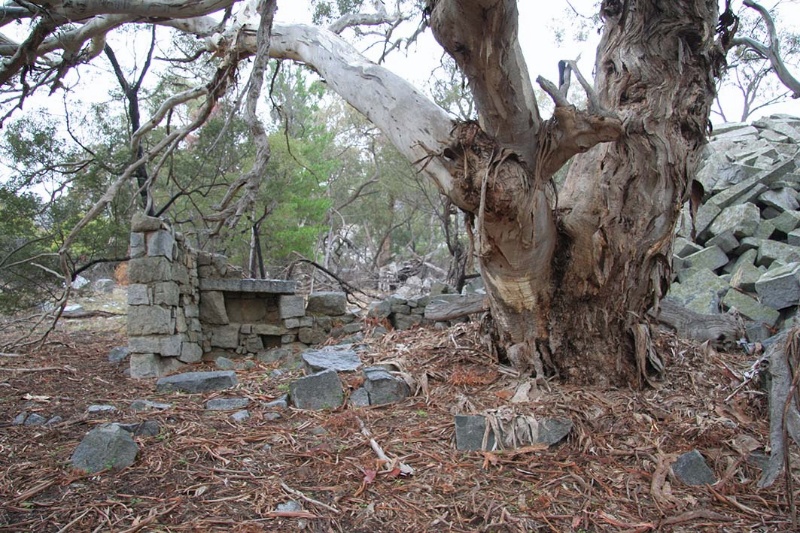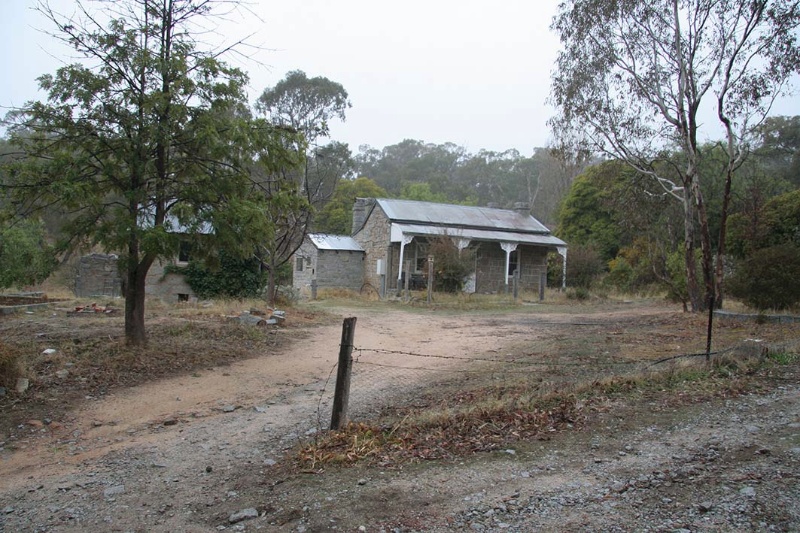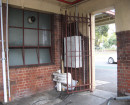BLIGHTS QUARRY
114 COOPERS ROAD HARCOURT NORTH, MOUNT ALEXANDER SHIRE
-
Add to tour
You must log in to do that.
-
Share
-
Shortlist place
You must log in to do that.
- Download report













Statement of Significance
What is significant
Blight's Quarry, opened in 1862 and located on the north-east lower slopes of Mt Alexander, consists of an eight metre high and 90 metres wide upper quarry face with sloping excavation and side walls extending for approximately 100 metres below. A layered succession of linear spoil heaps of granite blocks indicates the use of tramways to transport waste away from the quarrying area. Waste granite was also used to construct substantial mounting platforms for the Scotch derrick cranes which were used extensively within the quarry. A corrugated iron clad timber shed contains machinery mountings, and nearby are mounts for a compressed air tank. The ruins of a small building with fireplace below the earliest waste piles may indicate an early residence. Just below on the approach road is a small granite cottage and associated small two-storied building which probably date from the 1860s or 70s. A small early twentieth century timber bungalow is located nearby. The buildings are surrounded by remnant garden with orchard and ornamental planting. Fireplaces from small dwellings which may have accommodated quarrymen are located high on the southern corner of the site.
Large scale quarrying of granite in the Mt Alexander - Ravenswood area started in 1859 with stone supplied to the Melbourne to Echuca Railway. Cornish quarryman Joseph Blight arrived in the colony in 1855, and achieved some success in quartz reef mining at Eureka Reef in the Chewton/Campbells Creek area. He then turned to quarrying at Mount Alexander, at first providing stone for the railway. He began to work the Blight's Quarry site in 1862. The location on the lower slopes of the mountain made for easy transport of stone and waste. There was also a fortuitous alignment of bedding, joints and 'freeway' which allowed dimension stone to be extracted with ease. On the other hand, the presence of flaws including xenoliths ('black spot'), meant that there was considerable wastage of stone, reflected in the extensive waste heaps on the site. Blight and his wife moved to Castlemaine around 1890, leaving management to another Cornishman, John Jennings. Blight died in 1897 but the business continued under the name J. Blight and Co. The peak of output in the 1910s has been attributed to the increasing popularity of the stone for monumental work in cemeteries. In this period there were seven cranes operating and sixteen men in regular employment. Despite the high demand, no other large quarry was established on the mount until the Harcourt Granite quarry was opened in the 1920s. Tingay and Oliver's quarry followed in the early1940s, along with a number of other smaller quarries. Use of stone in major buildings declined in the 1950s, but quarry was kept alive by the monumental trade. Blights quarry closed in 1964, with increasing competition from other quarries run by monumental masons who processed the stone on site.
At first Harcourt stone was used locally, but from the late 1880s it was used extensively on prestigious buildings in the centre of Melbourne. Buildings and monuments which used stone from Blight's Quarry include the Burke and Wills Memorial in the Melbourne General Cemetery (1864), the Princes Bridge (1888), Block Arcade (1892), Equitable Building Collins Street (1896, demolished, stones now displayed in front of the Exhibition Building), Burns Memorial (1903, originally St. Kilda Road, now Treasury Gardens), Flinders Street Station (1910), Former National Bank of Australasia Head Office Collins Street (1927). From the 1880s, stone from Blight's Quarry was exported to New Zealand and Europe. The quarry received a gold medal in the Franco-British Exhibition in London in 1908.
How is it significant
Blight's Quarry is of historical significance to the State of Victoria.
Why is it significant
Blight's Quarry is of historical significance for its capacity to represent the quarrying of Harcourt granite, a high quality stone which was used in the local area from the late 1850s and was used extensively on major buildings and monuments in Melbourne from the 1880s. The stone was also used extensively for monumental work in cemeteries around Australia and was exported in quantity to Europe and New Zealand.
Blight's Quarry is of historical significance for its association with the gold rush in Victoria and as an example of how gold rush immigrants turned to their former trades as the gold ran out.
Blight's Quarry is of historical significance as the only large quarry working on Mount Alexander from 1862 up until the 1920s and as the quarry which best represents nineteenth century quarrying of this stone.
Blight's Quarry is of historical significance for its potential to reveal information about technology and work practices of granite quarrying from the 1860s up to the mid-twentieth century. The site also has the potential to be used to educate on the technology and work practices of granite quarrying over that period. The site has features which dramatically illustrate the processes of production of dimension stone, including extraction from the quarry face, cutting to size and movement of stone and which demonstrate the manual nature of the work in the nineteenth and early twentieth century.
-
-
BLIGHTS QUARRY - Plaque Citation
Opened in 1862 by Cornish quarryman Joseph Blight, this quarry produced large quantities of fine stone for 100 years. Harcourt granite dominated the Victorian market and was used in the bases and decoration of many major buildings in central Melbourne.
BLIGHTS QUARRY - Permit Exemptions
General Exemptions:General exemptions apply to all places and objects included in the Victorian Heritage Register (VHR). General exemptions have been designed to allow everyday activities, maintenance and changes to your property, which don’t harm its cultural heritage significance, to proceed without the need to obtain approvals under the Heritage Act 2017.Places of worship: In some circumstances, you can alter a place of worship to accommodate religious practices without a permit, but you must notify the Executive Director of Heritage Victoria before you start the works or activities at least 20 business days before the works or activities are to commence.Subdivision/consolidation: Permit exemptions exist for some subdivisions and consolidations. If the subdivision or consolidation is in accordance with a planning permit granted under Part 4 of the Planning and Environment Act 1987 and the application for the planning permit was referred to the Executive Director of Heritage Victoria as a determining referral authority, a permit is not required.Specific exemptions may also apply to your registered place or object. If applicable, these are listed below. Specific exemptions are tailored to the conservation and management needs of an individual registered place or object and set out works and activities that are exempt from the requirements of a permit. Specific exemptions prevail if they conflict with general exemptions. Find out more about heritage permit exemptions here.Specific Exemptions:General Conditions: 1. All exempted alterations are to be planned and carried out in a manner which prevents damage to the fabric of the registered place or object. General Conditions: 2. Should it become apparent during further inspection or the carrying out of works that original or previously hidden or inaccessible details of the place or object are revealed which relate to the significance of the place or object, then the exemption covering such works shall cease and Heritage Victoria shall be notified as soon as possible. Note: All archaeological places have the potential to contain significant sub-surface artefacts and other remains. In most cases it will be necessary to obtain approval from the Executive Director, Heritage Victoria before the undertaking any works that have a significant sub-surface component. General Conditions: 3. If there is a conservation policy and plan endorsed by the Executive Director, all works shall be in accordance with it. Note: The existence of a Conservation Management Plan or a Heritage Action Plan endorsed by the Executive Director, Heritage Victoria provides guidance for the management of the heritage values associated with the site. It may not be necessary to obtain a heritage permit for certain works specified in the management plan. General Conditions: 4. Nothing in this determination prevents the Executive Director from amending or rescinding all or any of the permit exemptions. General Conditions: 5. Nothing in this determination exempts owners or their agents from the responsibility to seek relevant planning or building permits from the responsible authorities where applicable. Regular Site Maintenance : The following site maintenance works are permit exempt under section 66 of the Heritage Act 1995: a) regular site maintenance provided the works do not involve the removal or destruction of any significant above-ground features or sub-surface archaeological artefacts or deposits; b) the maintenance of an item to retain its conditions or operation without the removal of or damage to the existing fabric or the introduction of new materials; c) cleaning including the removal of surface deposits, organic growths, or graffiti by the use of low pressure water and natural detergents and mild brushing and scrubbing; d) repairs, conservation and maintenance to plaques, memorials, roads and paths, fences and gates and drainage and irrigation. e) the replacement of existing services such as cabling, plumbing, wiring and fire services that uses existing routes, conduits or voids, and does not involve damage to or the removal of significant fabric. Note: Surface patina which has developed on the fabric may be an important part of the item's significance and if so needs to be preserved during maintenance and cleaning. Note: Any new materials used for repair must not exacerbate the decay of existing fabric due to chemical incompatibility, obscure existing fabric or limit access to existing fabric for future maintenance. Repair must maximise protection and retention of fabric and include the conservation of existing details or elements. Fire Suppression Duties : The following fire suppression duties are permit exempt under section 66 of the Heritage Act 1995, a) Fire suppression and fire fighting duties provided the works do not involve the removal or destruction of any significant above-ground features or sub-surface archaeological artefacts or deposits; b) Fire suppression activities such as fuel reduction burns, and fire control line construction, provided all significant historical and archaeological features are appropriately recognised and protected; Note: Fire management authorities should be aware of the location, extent and significance of historical and archaeological places when developing fire suppression and fire fighting strategies. The importance of places listed in the Heritage Register must be considered when strategies for fire suppression and management are being developed. Weed and Vermin Control : The following weed and vermin control activities are permit exempt under section 66 of the Heritage Act 1995, a) Weed and vermin control activities provided the works do not involve the removal or destruction of any significant above-ground features or sub-surface archaeological artefacts or deposits; Note: Particular care must be taken with weed and vermin control works where such activities may have a detrimental affect on the significant fabric of a place. Such works may include the removal of ivy, moss or lichen from an historic structure or feature, or the removal of burrows from a site that has archaeological values. Landscape Maintenance : The following landscape maintenance works are permit exempt under section 66 of the Heritage Act 1995, a) landscape maintenance works provided the activities do not involve the removal or destruction of any significant above-ground features or sub-surface archaeological artefacts or deposits; b) watering, mowing, top-dressing and fertilising necessary for the continued health of plants, without damage or major alterations to layout, contours, plant species or other significant landscape features; c) Management of trees in accordance with Australian Standard; Pruning of Amenity Trees AS 4373. d) tree surgery by a qualified horticulturalist or tree surgeon necessary for the health of those plants. Public Safety and Security : The following public safety and security activities are permit exempt under section 66 of the Heritage Act 1995, a) public safety and security activities provided the works do not involve the removal or destruction of any significant above-ground structures or sub-surface archaeological artefacts or deposits; b) the erection of temporary security fencing, scaffolding, hoardings or surveillance systems to prevent unauthorised access or secure public safety which will not adversely affect significant fabric of the place including archaeological features; c) development including emergency stabilisation necessary to secure safety where a site feature has been irreparably damaged or destabilised and represents a safety risk to its users or the public. Note: Urgent or emergency site works are to be undertaken by an appropriately qualified specialist such as a structural engineer, or other heritage professional. Signage and Site Interpretation : The following Signage and Site Interpretation activities are permit exempt under section 66 of the Heritage Act 1995, a) signage and site interpretation activities provided the works do not involve the removal or destruction of any significant above-ground structures or sub-surface archaeological artefacts or deposits; b) the erection of non-illuminated signage for the purpose of ensuring public safety or to assist in the interpretation of the heritage significance of the place or object and which will not adversely affect significant fabric including landscape or archaeological features of the place or obstruct significant views of and from heritage values or items; c) signage and site interpretation products must be located and be of a suitable size so as not to obscure or damage significant fabric of the place; d) signage and site interpretation products must be able to be later removed without causing damage to the significant fabric of the place; Note: The development of signage and site interpretation products must be consistent in the use of format, text, logos, themes and other display materials. Note: Where possible, the signage and interpretation material should be consistent with other schemes developed on similar or associated sites. It may be necessary to consult with land managers and other stakeholders concerning existing schemes and strategies for signage and site interpretation. Mineral Exploration : The following Mineral Exploration activities are permit exempt under section 66 of the Heritage Act 1995, a) mineral Exploration activities provided the works do not involve the removal or destruction of any significant above-ground features or sub-surface archaeological artefacts or deposits; b) preliminary non-intrusive exploration, including geological mapping, geophysical surveys, and geochemical sampling and access to shafts and adits; c) advanced forms of exploration (drilling), including the location of drill pads and access tracks where this has been the subject of on-site negotiation and agreement with representatives of Heritage Victoria, DSE and Parks Victoria, and where all significant historic site features have been identified and protected as part of an approved work plan. Minor Works : Note: Any Minor Works that in the opinion of the Executive Director will not adversely affect the heritage significance of the place may be exempt from the permit requirements of the Heritage Act. A person proposing to undertake minor works may submit a proposal to the Executive Director. If the Executive Director is satisfied that the proposed works will not adversely affect the heritage values of the site, the applicant may be exempted from the requirement to obtain a heritage permit. If an applicant is uncertain whether a heritage permit is required, it is recommended that the permits co-ordinator be contacted.BLIGHTS QUARRY - Permit Exemption Policy
The layered evidence of quarrying activity on this site makes a very important contribution to its significance and to the understanding of how the quarrying work progressed over time. All of the heaps of worked and waste stone and stone structures on the site contribute to this significance and understanding.
While the quarry and waste heaps are the areas of greatest significance on the site, the cottage and associated buildings and old plantings relate to the residence of the owner and later the manager on the site, and the remnant fireplaceson the site are associated with workers' residences.These provide important context for understanding how the site operated.
The brick and stone structure adjacent to the residence (B2) which appears to be a swimming pool is of recent provenance and is of little significance. It could be removed but a permit would be required to ensure that the nearby chimney and other evidence of a former dwelling in that area was not disturbed in the process.
-
-
-
-
-
BLIGHTS QUARRY
 Victorian Heritage Register H2127
Victorian Heritage Register H2127
-
'CARINYA' LADSONS STORE
 Victorian Heritage Register H0568
Victorian Heritage Register H0568 -
1 Alexander Street
 Yarra City
Yarra City -
1 Botherambo Street
 Yarra City
Yarra City
-
-










